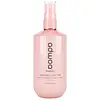What's inside
What's inside
 Key Ingredients
Key Ingredients

 Benefits
Benefits

 Concerns
Concerns

 Ingredients Side-by-side
Ingredients Side-by-side

Quaternium-91
Behentrimonium Chloride
PreservativeMyristyl Myristate
EmollientCetearyl Alcohol
EmollientAloe Barbadensis Leaf Juice
Skin ConditioningCetrimonium Chloride
AntimicrobialDiheptyl Succinate
EmollientCapryloyl Glycerin/Sebacic Acid Copolymer
Skin ConditioningSimmondsia Chinensis Seed Oil
EmollientPersea Gratissima Oil
Skin ConditioningOlea Europaea Fruit Oil
MaskingArgania Spinosa Kernel Oil
EmollientFragaria Ananassa Seed Oil
AntioxidantRubus Idaeus Seed Oil
EmollientCitrullus Lanatus Seed Oil
EmollientDehydroacetic Acid
PreservativeBenzyl Alcohol
PerfumingParfum
MaskingPanthenol
Skin ConditioningHibiscus Sabdariffa Flower Powder
AbrasiveQuaternium-91, Behentrimonium Chloride, Myristyl Myristate, Cetearyl Alcohol, Aloe Barbadensis Leaf Juice, Cetrimonium Chloride, Diheptyl Succinate, Capryloyl Glycerin/Sebacic Acid Copolymer, Simmondsia Chinensis Seed Oil, Persea Gratissima Oil, Olea Europaea Fruit Oil, Argania Spinosa Kernel Oil, Fragaria Ananassa Seed Oil, Rubus Idaeus Seed Oil, Citrullus Lanatus Seed Oil, Dehydroacetic Acid, Benzyl Alcohol, Parfum, Panthenol, Hibiscus Sabdariffa Flower Powder
Water
Skin ConditioningPropylene Glycol
HumectantDimethicone
EmollientMyristyl Alcohol
EmollientButylene Glycol
HumectantGlycerin
HumectantDiphenylsiloxy Phenyl Trimethicone
Skin ConditioningAminopropyl Dimethicone
Alcohol Denat.
AntimicrobialEthylhexylglycerin
Skin ConditioningGamma-Docosalactone
Skin ConditioningSteartrimonium Chloride
PreservativeCetearyl Alcohol
EmollientCaprylic/Capric Triglyceride
MaskingHydroxyethylcellulose
Emulsion StabilisingPhenoxyethanol
PreservativeBehentrimonium Chloride
PreservativePrunus Persica Kernel Oil
EmollientPrunus Persica Fruit Extract
AbrasiveDisodium EDTA
Parfum
MaskingWater, Propylene Glycol, Dimethicone, Myristyl Alcohol, Butylene Glycol, Glycerin, Diphenylsiloxy Phenyl Trimethicone, Aminopropyl Dimethicone, Alcohol Denat., Ethylhexylglycerin, Gamma-Docosalactone, Steartrimonium Chloride, Cetearyl Alcohol, Caprylic/Capric Triglyceride, Hydroxyethylcellulose, Phenoxyethanol, Behentrimonium Chloride, Prunus Persica Kernel Oil, Prunus Persica Fruit Extract, Disodium EDTA, Parfum
Ingredients Explained
These ingredients are found in both products.
Ingredients higher up in an ingredient list are typically present in a larger amount.
This ingredient is a preservative and often used for it's anti-static properties. You'll most likely see this ingredient in hair conditioners.
It does not cause irritation or sensitization in leave-on products at 1-5%.
Cetearyl alcohol is a mixture of two fatty alcohols: cetyl alcohol and stearyl alcohol. It is mainly used as an emulsifier. Emulsifiers help prevent the separation of oils and products. Due to its composition, it can also be used to thicken a product or help create foam.
Cetearyl alcohol is an emollient. Emollients help soothe and hydrate the skin by trapping moisture.
Studies show Cetearyl alcohol is non-toxic and non-irritating. The FDA allows products labeled "alcohol-free" to have fatty alcohols.
This ingredient is usually derived from plant oils such as palm, vegetable, or coconut oils. There is debate on whether this ingredient will cause acne.
Due to the fatty acid base, this ingredient may not be Malassezia folliculitis safe.
Learn more about Cetearyl AlcoholParfum is a catch-all term for an ingredient or more that is used to give a scent to products.
Also called "fragrance", this ingredient can be a blend of hundreds of chemicals or plant oils. This means every product with "fragrance" or "parfum" in the ingredients list is a different mixture.
For instance, Habanolide is a proprietary trade name for a specific aroma chemical. When used as a fragrance ingredient in cosmetics, most aroma chemicals fall under the broad labeling category of “FRAGRANCE” or “PARFUM” according to EU and US regulations.
The term 'parfum' or 'fragrance' is not regulated in many countries. In many cases, it is up to the brand to define this term.
For instance, many brands choose to label themselves as "fragrance-free" because they are not using synthetic fragrances. However, their products may still contain ingredients such as essential oils that are considered a fragrance by INCI standards.
One example is Calendula flower extract. Calendula is an essential oil that still imparts a scent or 'fragrance'.
Depending on the blend, the ingredients in the mixture can cause allergies and sensitivities on the skin. Some ingredients that are known EU allergens include linalool and citronellol.
Parfum can also be used to mask or cover an unpleasant scent.
The bottom line is: not all fragrances/parfum/ingredients are created equally. If you are worried about fragrances, we recommend taking a closer look at an ingredient. And of course, we always recommend speaking with a professional.
Learn more about Parfum